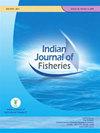通过农村妇女的参与改善家庭鱼类和蔬菜供应:案例研究
IF 0.3
4区 农林科学
Q4 FISHERIES
引用次数: 0
摘要
家庭综合水产养殖在减少贫困和营养不良方面具有巨大潜力。为了通过小规模水产养殖创新产生可持续和公平的影响,需要在设计和推广之初就关注性别问题。本案例研究展示了性别包容干预措施在提高妇女参与家庭水产养殖方面的影响,从而改善了家庭鱼类和蔬菜的供应和收入。通过故意将本土小型鱼类与印度主要鲤科鱼类(IMCs)一起养殖,保护日益减少的本土小型鱼类种群也是本研究的一个重点。在对妇女进行科学水产养殖管理实践的能力建设时,采用了一种性别包容的方法。在奥德赛州普里区,从四个村庄中挑选了 24 个面积在 0.17-0.22 公顷之间的自家池塘(总面积为 4 公顷)进行参与式行动研究。池塘中放养了 IMCs @10000 ha-1 和本地小鱼,如 Amblyphanrynogon mola 和 Puntius spp.@25000 ha-1。25000 公顷-1。为了提高妇女在家庭综合水产养殖中的参与度,还在村里引入了一些对妇女友好的干预措施,如刺网(网目尺寸为 12 毫米),这是一种被动式渔具,池塘外围的棚架系统用于种植攀缘植物。妇女参与使用刺网和陷阱等被动渔具捕捞小鱼,使农村家庭每两周可定期获得约 750 克富含微量营养素的小鱼。按照种植日历利用池塘埂种植蔬菜,每公顷池塘面积可生产约 790 公斤蔬菜。研究表明,妇女通过参与家庭综合水产养殖,可以为增加和稳定家庭收入以及改善家庭营养状况做出巨大贡献。研究还证明,通过科学的管理方法将综合水产养殖与本地小型鱼类进行综合养殖,将获得更好的产量,提高家庭的鱼类供应量,并更好地管理家庭资源。关键词水产养殖、赋权、家庭、园艺、参与、妇女本文章由计算机程序翻译,如有差异,请以英文原文为准。
Improving household fish and vegetable availability through participation of rural women: A case study
Homestead integrated aquaculture has immense potential towards alleviating poverty andundernourishment. In order to have sustainable and equitable impacts through small holderaquaculture innovations, a focus on gender being included at the very start of the designand dissemination is required. The present case study showcases the impact of genderinclusive interventions in improving the participation of women in homestead aquaculture,thereby improving the household fish and vegetable availability and income. Conservation ofthe diminishing stock of small indigenous fishes by deliberately farming them along with theIndian major carps (IMCs) was also a focus of the study. A gender inclusive approach wasadopted in the capacity building of women on scientific aquaculture management practices.Twenty four homestead ponds having areas ranging from 0.17-0.22 ha in Puri District, Odishacovering a total area of 4 ha from four villages were selected to undertake participatoryaction research. The ponds were stocked with IMCs @10000 ha-1 and small indigenousfishes like Amblyphanrynogon mola and Puntius spp. @25000 ha-1. Several women friendlyinterventions like gillnets (mesh size 12 mm) a passive fishing gear and trellis systemaround pond bund for growing climber vegetables were introduced in the villages with anaim to improve the participation of women in homestead integrated aquaculture. As a resultof the interventions, the fish production increased from 0.75 t ha-1 yr-1 to 2.48 t ha-1 yr-1.The involvement of women in harvesting of small fish using passive gear like gillnets andtraps resulted in regular fortnightly availability of around 750 g of small micronutrient richfish to rural families. The utilisation of pond bund for growing vegetables following thecropping calendar resulted in production around 790 kg vegetables per hectare of pondarea. The study showed that women can immensely contribute to increasing and stabilisingfamily income and in improving family nutrition by participating in homestead integratedaquaculture. The research also proved that polyculture of IMCs with small indigenous fishesby following the scientific management practices will result in better yield, improved fishavailability to the house and better management of the household resources. Keywords: Aquaculture, Empowerment, Household, Horticulture, Participation, Women
求助全文
通过发布文献求助,成功后即可免费获取论文全文。
去求助
来源期刊

Indian Journal of Fisheries
FISHERIES-
CiteScore
0.90
自引率
20.00%
发文量
0
审稿时长
6-12 weeks
期刊介绍:
Indian Journal of Fisheries is published quarterly by the Indian Council of Agricultural Research (ICAR), New Delhi. Original contributions in the field of Fish and fisheries science are considered for publication in the Journal. The material submitted must be unpublished and not under consideration for publication elsewhere.
Papers based on research which kills or damages any species, regarded as thratened/ endangered by IUCN crieteria or is as such listed in the Red Data Book appropriate to the geographic area concerned, will not be accepted by the Journal, unless the work has clear conservation objectives.
 求助内容:
求助内容: 应助结果提醒方式:
应助结果提醒方式:


